Economics of the UK Housing Market: Analysis of Trends and Factors
VerifiedAdded on 2021/04/24
|17
|3292
|226
Report
AI Summary
This report provides a comprehensive analysis of the UK housing market, examining trends in house prices from 2006 to 2016, with a particular focus on the factors influencing these prices. It delves into both demand-side factors, such as economic growth, affordability, interest rates, population, and mortgage availability, and supply-side factors, including construction rates and planning restrictions. The report also investigates the implications of housing shortages and evaluates the impact of various government schemes, including Help to Buy and Shared Ownership, on the housing market and affordability. The analysis highlights the interplay of economic conditions, government interventions, and market dynamics, providing a detailed understanding of the UK housing sector.
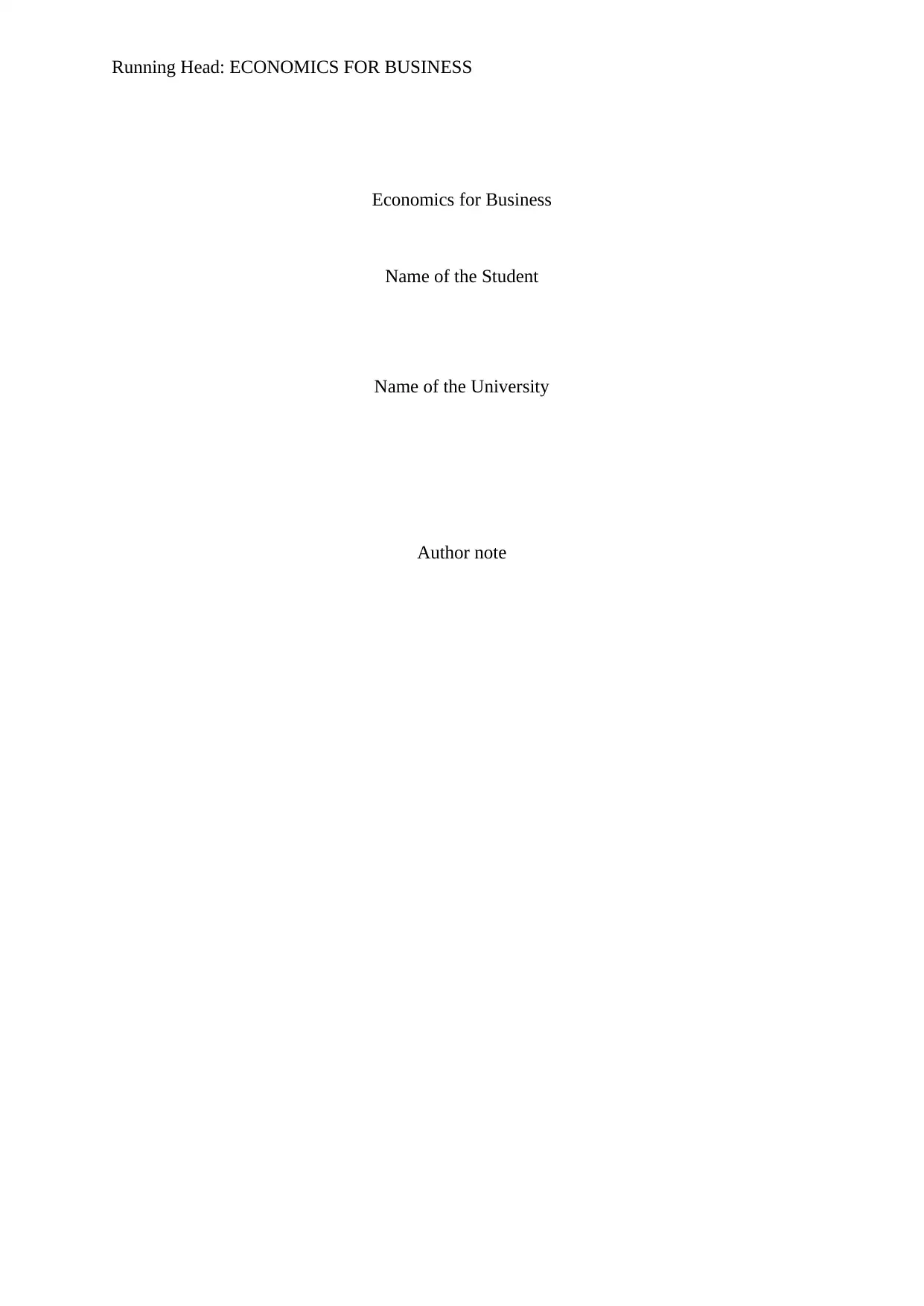
Running Head: ECONOMICS FOR BUSINESS
Economics for Business
Name of the Student
Name of the University
Author note
Economics for Business
Name of the Student
Name of the University
Author note
Secure Best Marks with AI Grader
Need help grading? Try our AI Grader for instant feedback on your assignments.
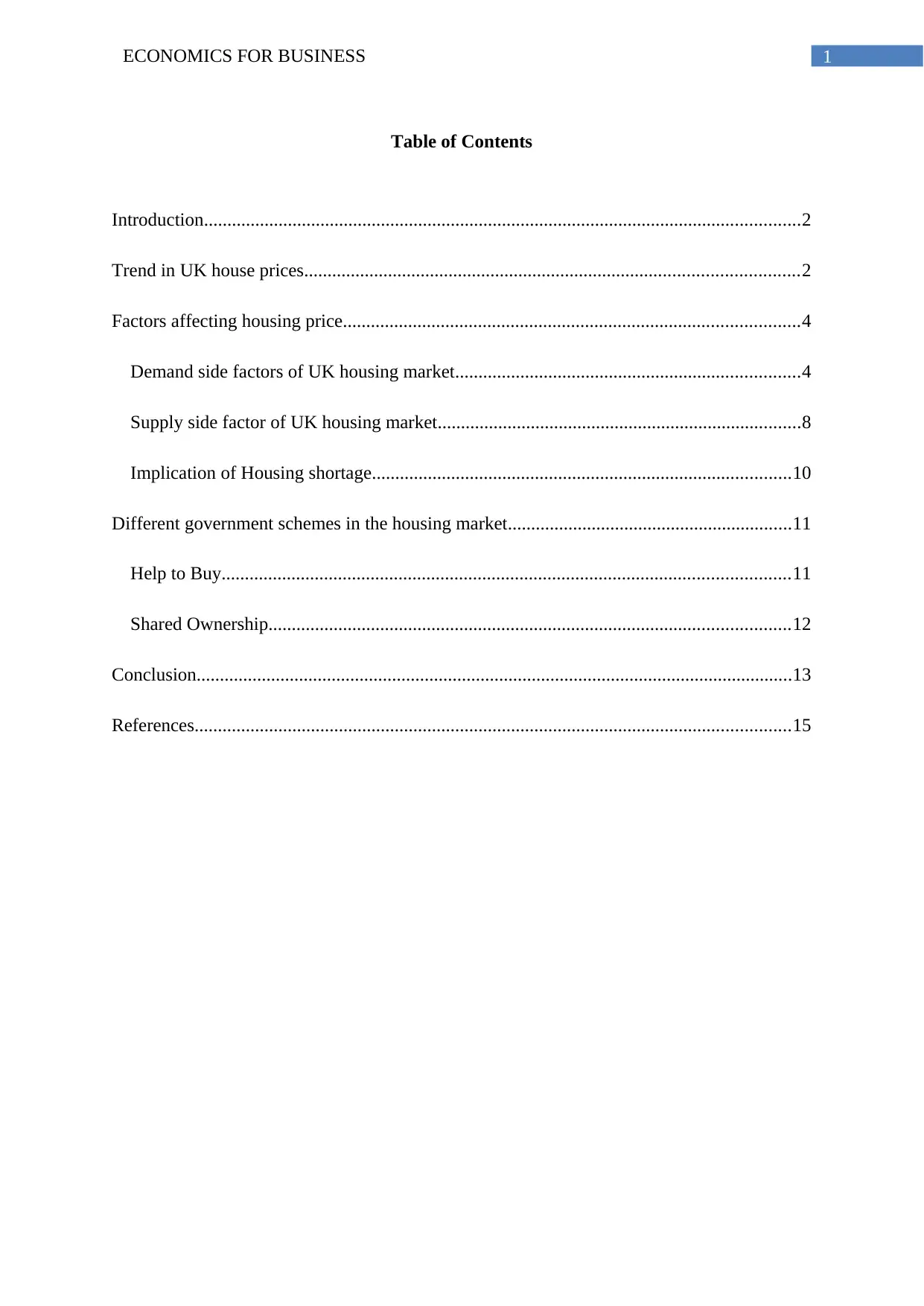
1ECONOMICS FOR BUSINESS
Table of Contents
Introduction................................................................................................................................2
Trend in UK house prices..........................................................................................................2
Factors affecting housing price..................................................................................................4
Demand side factors of UK housing market..........................................................................4
Supply side factor of UK housing market..............................................................................8
Implication of Housing shortage..........................................................................................10
Different government schemes in the housing market.............................................................11
Help to Buy..........................................................................................................................11
Shared Ownership................................................................................................................12
Conclusion................................................................................................................................13
References................................................................................................................................15
Table of Contents
Introduction................................................................................................................................2
Trend in UK house prices..........................................................................................................2
Factors affecting housing price..................................................................................................4
Demand side factors of UK housing market..........................................................................4
Supply side factor of UK housing market..............................................................................8
Implication of Housing shortage..........................................................................................10
Different government schemes in the housing market.............................................................11
Help to Buy..........................................................................................................................11
Shared Ownership................................................................................................................12
Conclusion................................................................................................................................13
References................................................................................................................................15
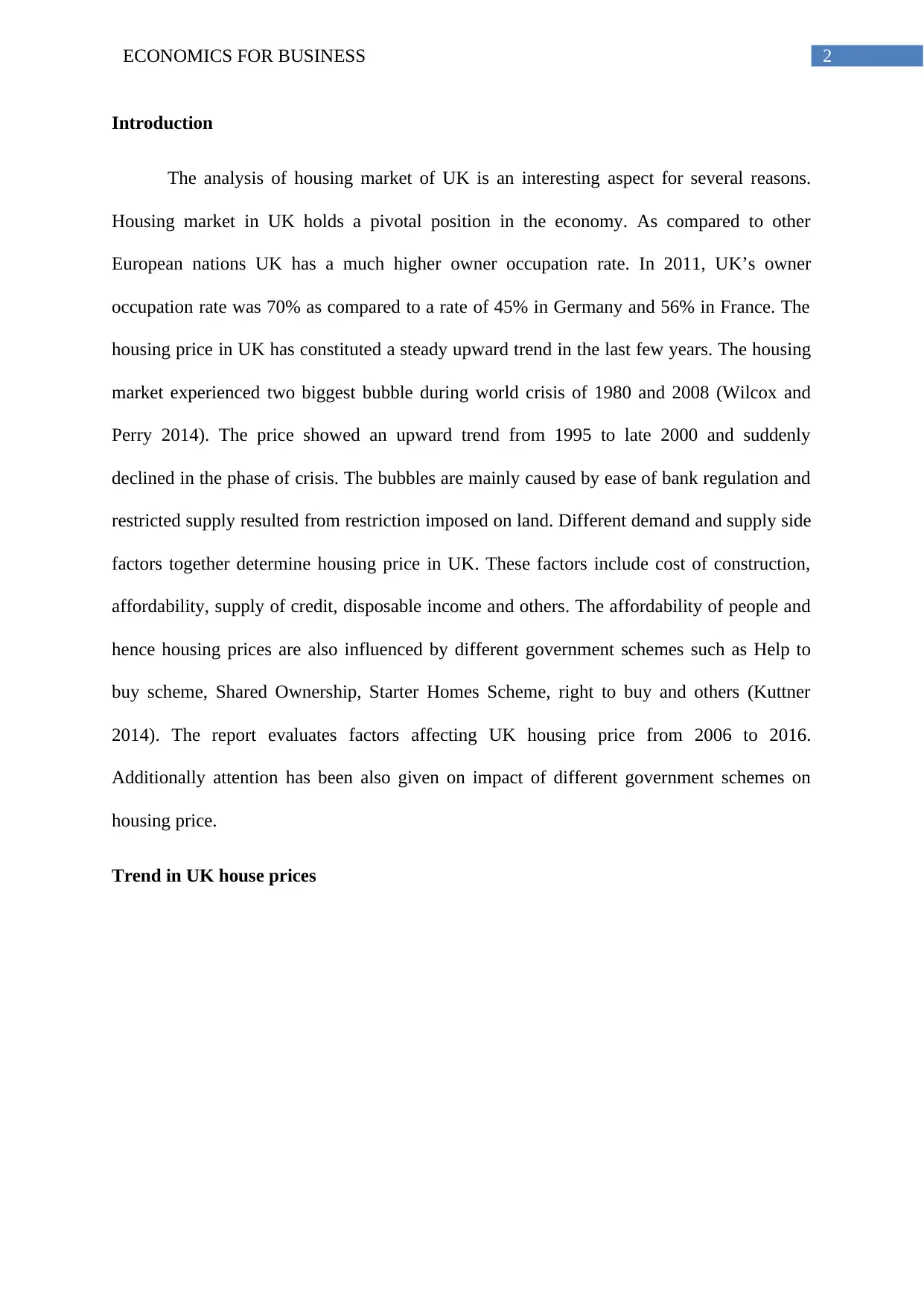
2ECONOMICS FOR BUSINESS
Introduction
The analysis of housing market of UK is an interesting aspect for several reasons.
Housing market in UK holds a pivotal position in the economy. As compared to other
European nations UK has a much higher owner occupation rate. In 2011, UK’s owner
occupation rate was 70% as compared to a rate of 45% in Germany and 56% in France. The
housing price in UK has constituted a steady upward trend in the last few years. The housing
market experienced two biggest bubble during world crisis of 1980 and 2008 (Wilcox and
Perry 2014). The price showed an upward trend from 1995 to late 2000 and suddenly
declined in the phase of crisis. The bubbles are mainly caused by ease of bank regulation and
restricted supply resulted from restriction imposed on land. Different demand and supply side
factors together determine housing price in UK. These factors include cost of construction,
affordability, supply of credit, disposable income and others. The affordability of people and
hence housing prices are also influenced by different government schemes such as Help to
buy scheme, Shared Ownership, Starter Homes Scheme, right to buy and others (Kuttner
2014). The report evaluates factors affecting UK housing price from 2006 to 2016.
Additionally attention has been also given on impact of different government schemes on
housing price.
Trend in UK house prices
Introduction
The analysis of housing market of UK is an interesting aspect for several reasons.
Housing market in UK holds a pivotal position in the economy. As compared to other
European nations UK has a much higher owner occupation rate. In 2011, UK’s owner
occupation rate was 70% as compared to a rate of 45% in Germany and 56% in France. The
housing price in UK has constituted a steady upward trend in the last few years. The housing
market experienced two biggest bubble during world crisis of 1980 and 2008 (Wilcox and
Perry 2014). The price showed an upward trend from 1995 to late 2000 and suddenly
declined in the phase of crisis. The bubbles are mainly caused by ease of bank regulation and
restricted supply resulted from restriction imposed on land. Different demand and supply side
factors together determine housing price in UK. These factors include cost of construction,
affordability, supply of credit, disposable income and others. The affordability of people and
hence housing prices are also influenced by different government schemes such as Help to
buy scheme, Shared Ownership, Starter Homes Scheme, right to buy and others (Kuttner
2014). The report evaluates factors affecting UK housing price from 2006 to 2016.
Additionally attention has been also given on impact of different government schemes on
housing price.
Trend in UK house prices
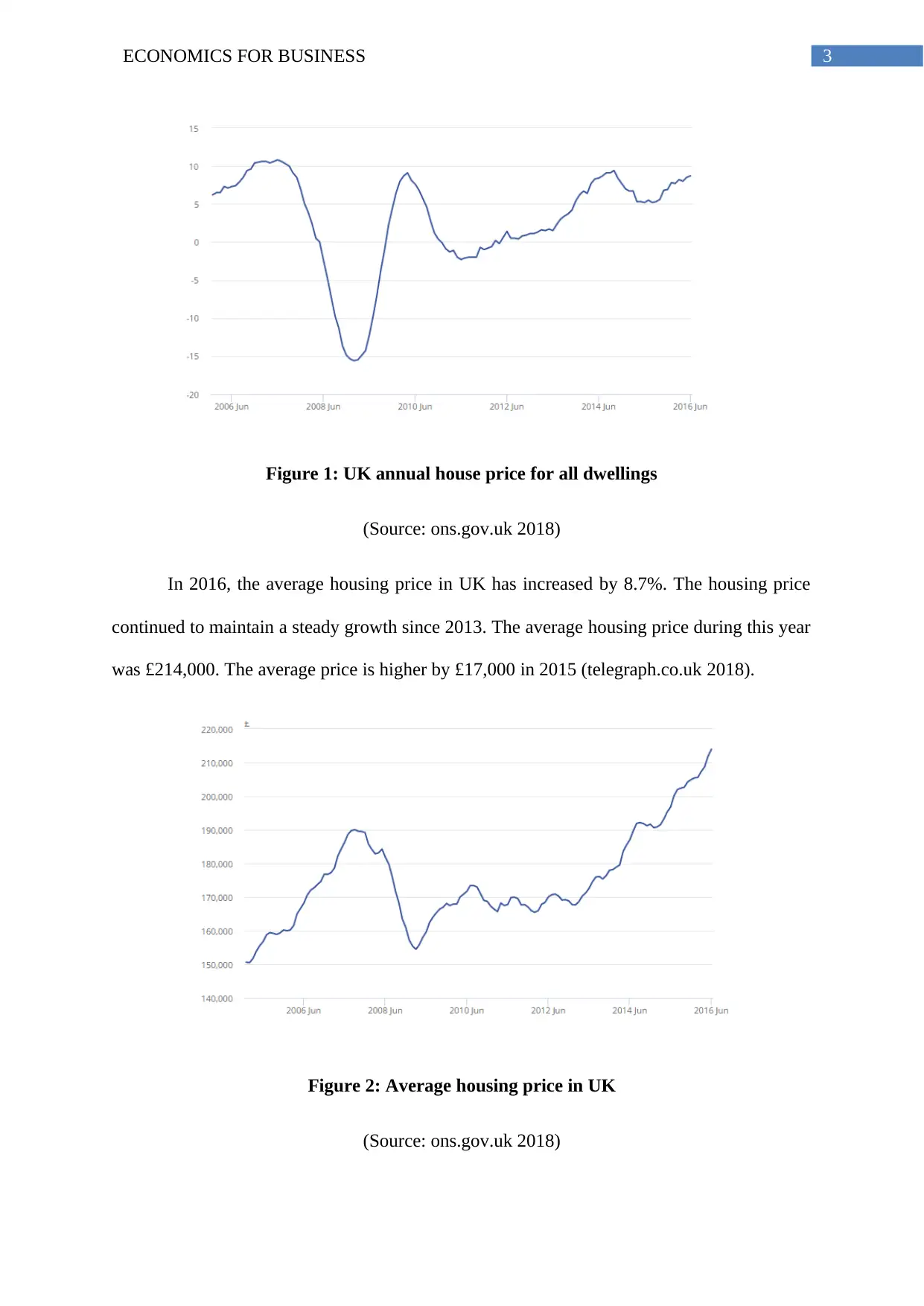
3ECONOMICS FOR BUSINESS
Figure 1: UK annual house price for all dwellings
(Source: ons.gov.uk 2018)
In 2016, the average housing price in UK has increased by 8.7%. The housing price
continued to maintain a steady growth since 2013. The average housing price during this year
was £214,000. The average price is higher by £17,000 in 2015 (telegraph.co.uk 2018).
Figure 2: Average housing price in UK
(Source: ons.gov.uk 2018)
Figure 1: UK annual house price for all dwellings
(Source: ons.gov.uk 2018)
In 2016, the average housing price in UK has increased by 8.7%. The housing price
continued to maintain a steady growth since 2013. The average housing price during this year
was £214,000. The average price is higher by £17,000 in 2015 (telegraph.co.uk 2018).
Figure 2: Average housing price in UK
(Source: ons.gov.uk 2018)
Secure Best Marks with AI Grader
Need help grading? Try our AI Grader for instant feedback on your assignments.
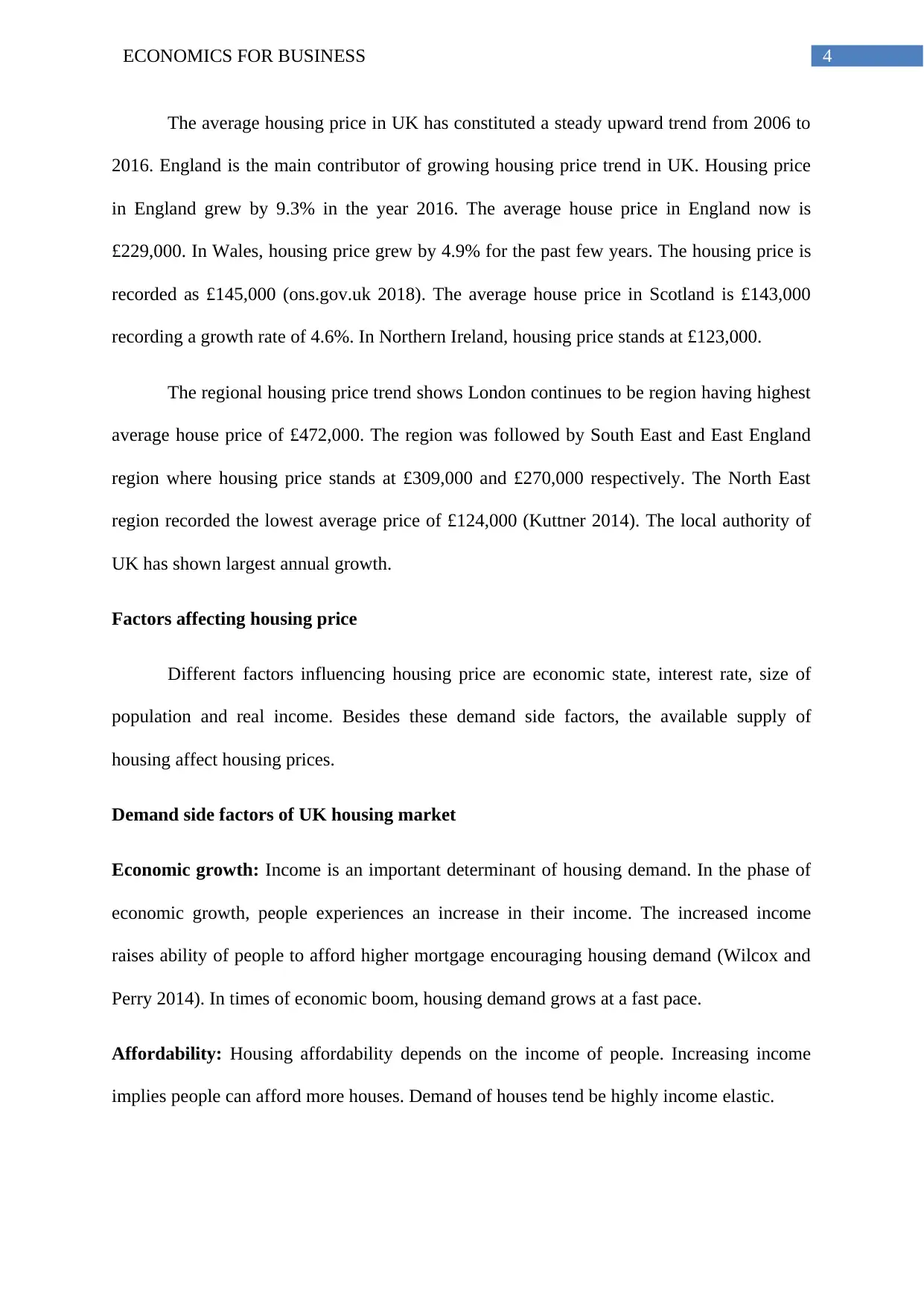
4ECONOMICS FOR BUSINESS
The average housing price in UK has constituted a steady upward trend from 2006 to
2016. England is the main contributor of growing housing price trend in UK. Housing price
in England grew by 9.3% in the year 2016. The average house price in England now is
£229,000. In Wales, housing price grew by 4.9% for the past few years. The housing price is
recorded as £145,000 (ons.gov.uk 2018). The average house price in Scotland is £143,000
recording a growth rate of 4.6%. In Northern Ireland, housing price stands at £123,000.
The regional housing price trend shows London continues to be region having highest
average house price of £472,000. The region was followed by South East and East England
region where housing price stands at £309,000 and £270,000 respectively. The North East
region recorded the lowest average price of £124,000 (Kuttner 2014). The local authority of
UK has shown largest annual growth.
Factors affecting housing price
Different factors influencing housing price are economic state, interest rate, size of
population and real income. Besides these demand side factors, the available supply of
housing affect housing prices.
Demand side factors of UK housing market
Economic growth: Income is an important determinant of housing demand. In the phase of
economic growth, people experiences an increase in their income. The increased income
raises ability of people to afford higher mortgage encouraging housing demand (Wilcox and
Perry 2014). In times of economic boom, housing demand grows at a fast pace.
Affordability: Housing affordability depends on the income of people. Increasing income
implies people can afford more houses. Demand of houses tend be highly income elastic.
The average housing price in UK has constituted a steady upward trend from 2006 to
2016. England is the main contributor of growing housing price trend in UK. Housing price
in England grew by 9.3% in the year 2016. The average house price in England now is
£229,000. In Wales, housing price grew by 4.9% for the past few years. The housing price is
recorded as £145,000 (ons.gov.uk 2018). The average house price in Scotland is £143,000
recording a growth rate of 4.6%. In Northern Ireland, housing price stands at £123,000.
The regional housing price trend shows London continues to be region having highest
average house price of £472,000. The region was followed by South East and East England
region where housing price stands at £309,000 and £270,000 respectively. The North East
region recorded the lowest average price of £124,000 (Kuttner 2014). The local authority of
UK has shown largest annual growth.
Factors affecting housing price
Different factors influencing housing price are economic state, interest rate, size of
population and real income. Besides these demand side factors, the available supply of
housing affect housing prices.
Demand side factors of UK housing market
Economic growth: Income is an important determinant of housing demand. In the phase of
economic growth, people experiences an increase in their income. The increased income
raises ability of people to afford higher mortgage encouraging housing demand (Wilcox and
Perry 2014). In times of economic boom, housing demand grows at a fast pace.
Affordability: Housing affordability depends on the income of people. Increasing income
implies people can afford more houses. Demand of houses tend be highly income elastic.
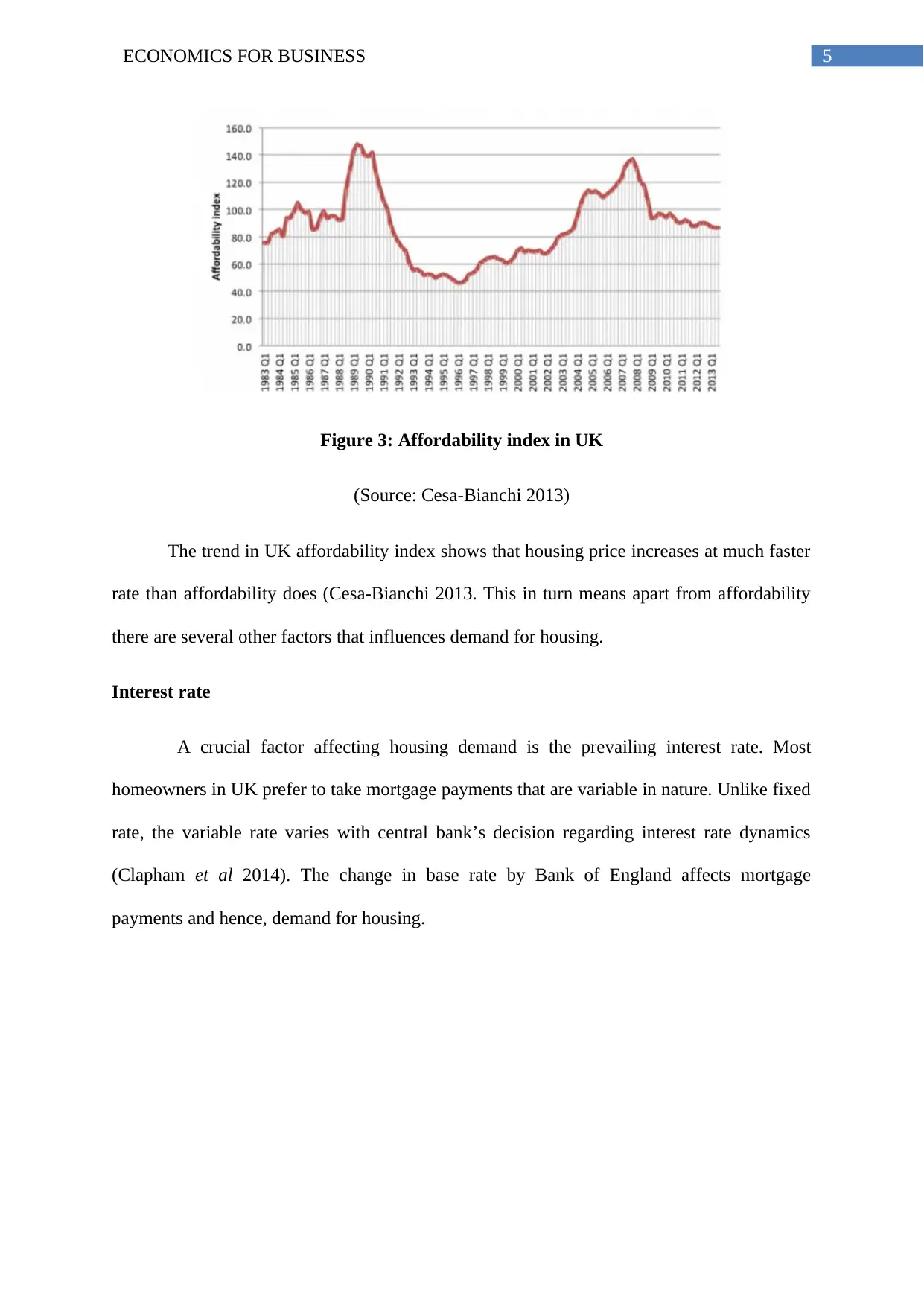
5ECONOMICS FOR BUSINESS
Figure 3: Affordability index in UK
(Source: Cesa-Bianchi 2013)
The trend in UK affordability index shows that housing price increases at much faster
rate than affordability does (Cesa-Bianchi 2013. This in turn means apart from affordability
there are several other factors that influences demand for housing.
Interest rate
A crucial factor affecting housing demand is the prevailing interest rate. Most
homeowners in UK prefer to take mortgage payments that are variable in nature. Unlike fixed
rate, the variable rate varies with central bank’s decision regarding interest rate dynamics
(Clapham et al 2014). The change in base rate by Bank of England affects mortgage
payments and hence, demand for housing.
Figure 3: Affordability index in UK
(Source: Cesa-Bianchi 2013)
The trend in UK affordability index shows that housing price increases at much faster
rate than affordability does (Cesa-Bianchi 2013. This in turn means apart from affordability
there are several other factors that influences demand for housing.
Interest rate
A crucial factor affecting housing demand is the prevailing interest rate. Most
homeowners in UK prefer to take mortgage payments that are variable in nature. Unlike fixed
rate, the variable rate varies with central bank’s decision regarding interest rate dynamics
(Clapham et al 2014). The change in base rate by Bank of England affects mortgage
payments and hence, demand for housing.
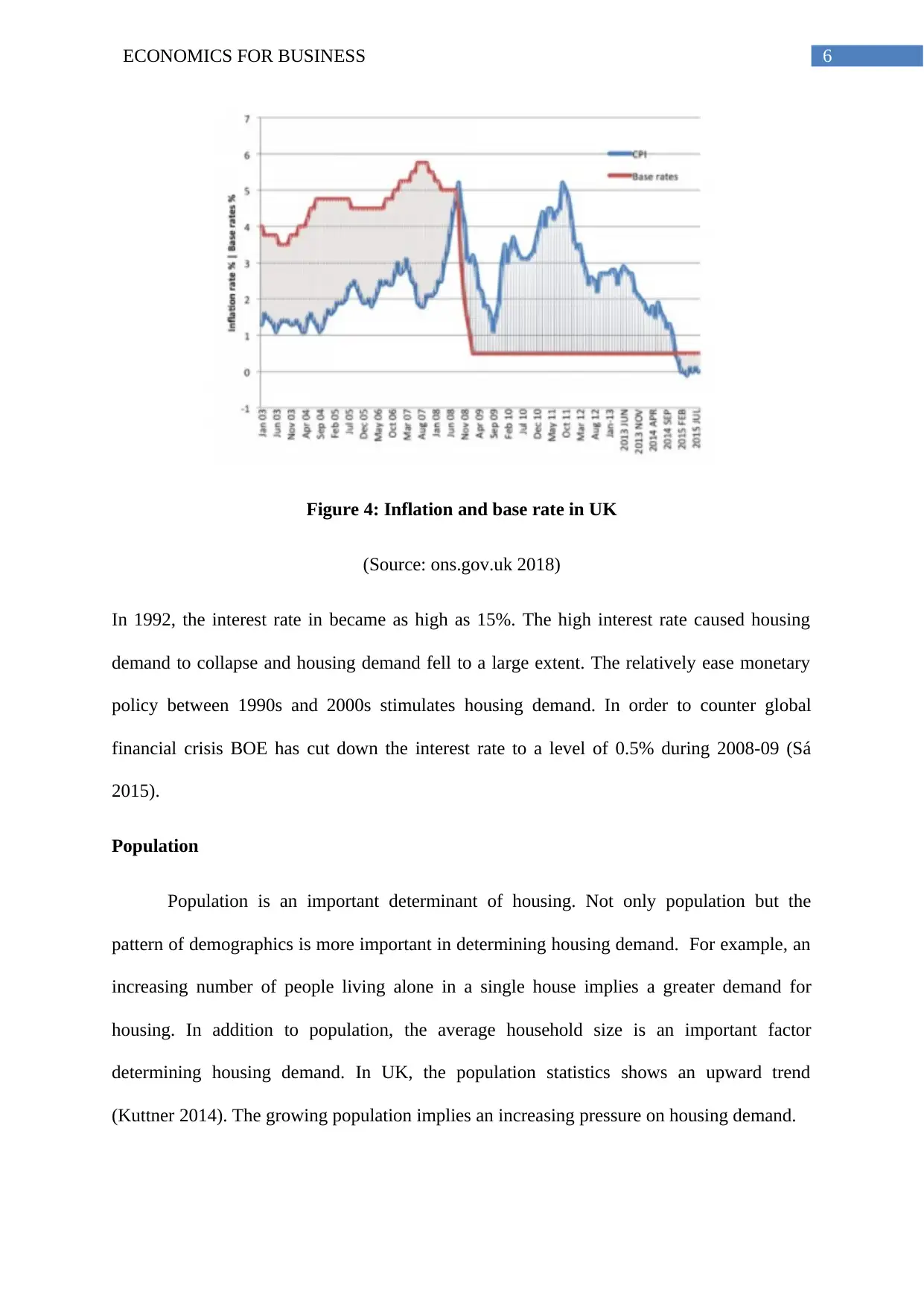
6ECONOMICS FOR BUSINESS
Figure 4: Inflation and base rate in UK
(Source: ons.gov.uk 2018)
In 1992, the interest rate in became as high as 15%. The high interest rate caused housing
demand to collapse and housing demand fell to a large extent. The relatively ease monetary
policy between 1990s and 2000s stimulates housing demand. In order to counter global
financial crisis BOE has cut down the interest rate to a level of 0.5% during 2008-09 (Sá
2015).
Population
Population is an important determinant of housing. Not only population but the
pattern of demographics is more important in determining housing demand. For example, an
increasing number of people living alone in a single house implies a greater demand for
housing. In addition to population, the average household size is an important factor
determining housing demand. In UK, the population statistics shows an upward trend
(Kuttner 2014). The growing population implies an increasing pressure on housing demand.
Figure 4: Inflation and base rate in UK
(Source: ons.gov.uk 2018)
In 1992, the interest rate in became as high as 15%. The high interest rate caused housing
demand to collapse and housing demand fell to a large extent. The relatively ease monetary
policy between 1990s and 2000s stimulates housing demand. In order to counter global
financial crisis BOE has cut down the interest rate to a level of 0.5% during 2008-09 (Sá
2015).
Population
Population is an important determinant of housing. Not only population but the
pattern of demographics is more important in determining housing demand. For example, an
increasing number of people living alone in a single house implies a greater demand for
housing. In addition to population, the average household size is an important factor
determining housing demand. In UK, the population statistics shows an upward trend
(Kuttner 2014). The growing population implies an increasing pressure on housing demand.
Paraphrase This Document
Need a fresh take? Get an instant paraphrase of this document with our AI Paraphraser
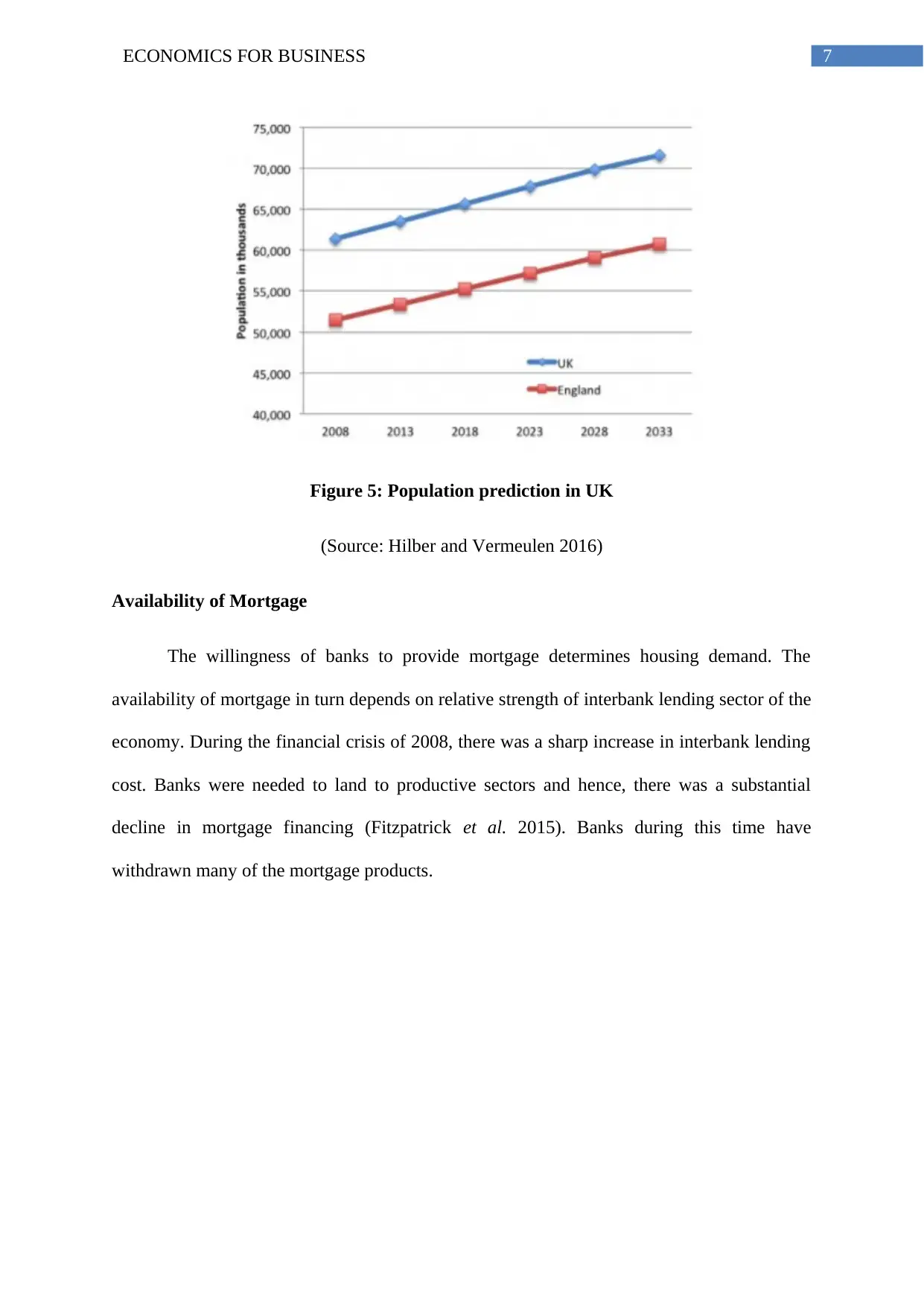
7ECONOMICS FOR BUSINESS
Figure 5: Population prediction in UK
(Source: Hilber and Vermeulen 2016)
Availability of Mortgage
The willingness of banks to provide mortgage determines housing demand. The
availability of mortgage in turn depends on relative strength of interbank lending sector of the
economy. During the financial crisis of 2008, there was a sharp increase in interbank lending
cost. Banks were needed to land to productive sectors and hence, there was a substantial
decline in mortgage financing (Fitzpatrick et al. 2015). Banks during this time have
withdrawn many of the mortgage products.
Figure 5: Population prediction in UK
(Source: Hilber and Vermeulen 2016)
Availability of Mortgage
The willingness of banks to provide mortgage determines housing demand. The
availability of mortgage in turn depends on relative strength of interbank lending sector of the
economy. During the financial crisis of 2008, there was a sharp increase in interbank lending
cost. Banks were needed to land to productive sectors and hence, there was a substantial
decline in mortgage financing (Fitzpatrick et al. 2015). Banks during this time have
withdrawn many of the mortgage products.
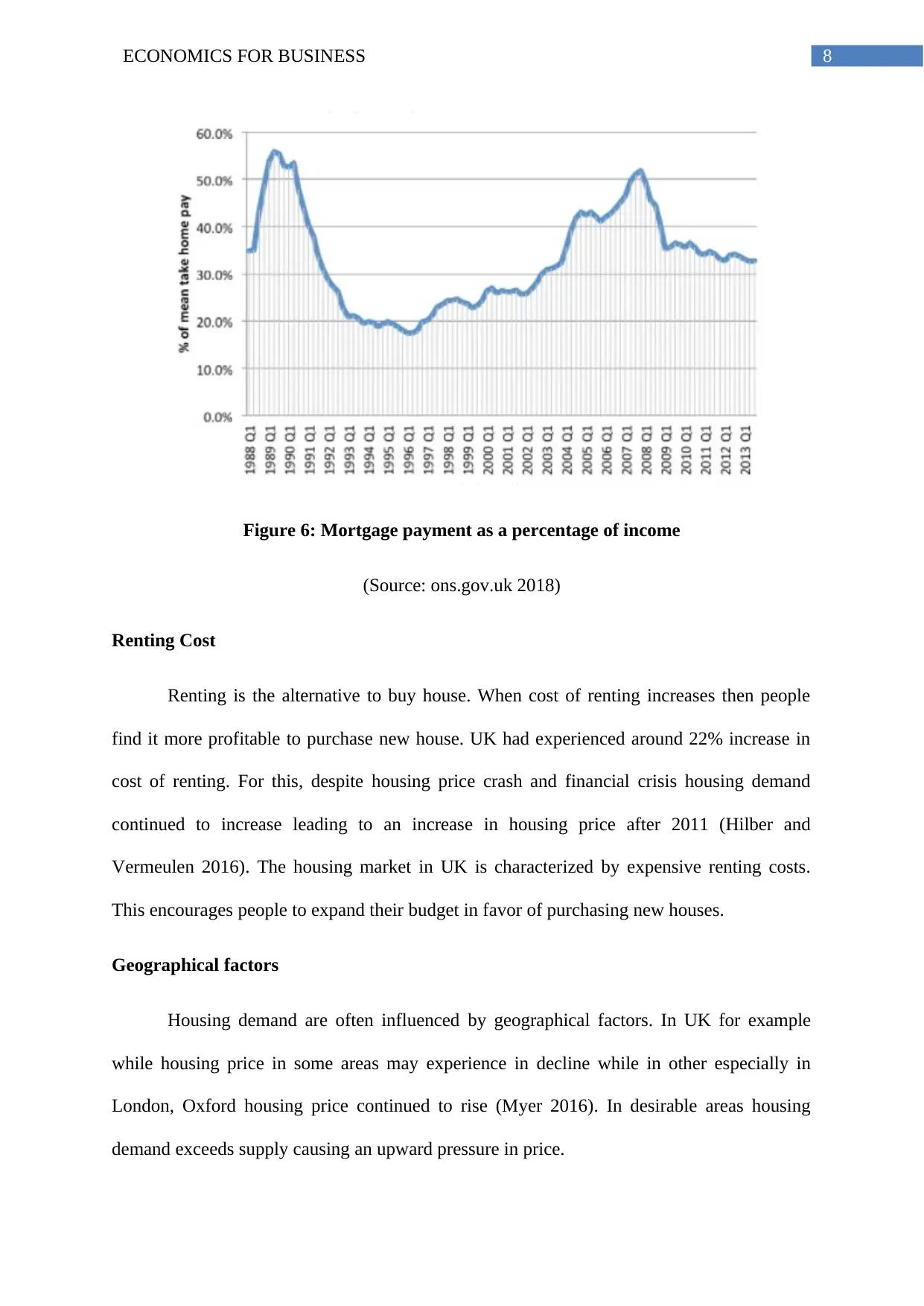
8ECONOMICS FOR BUSINESS
Figure 6: Mortgage payment as a percentage of income
(Source: ons.gov.uk 2018)
Renting Cost
Renting is the alternative to buy house. When cost of renting increases then people
find it more profitable to purchase new house. UK had experienced around 22% increase in
cost of renting. For this, despite housing price crash and financial crisis housing demand
continued to increase leading to an increase in housing price after 2011 (Hilber and
Vermeulen 2016). The housing market in UK is characterized by expensive renting costs.
This encourages people to expand their budget in favor of purchasing new houses.
Geographical factors
Housing demand are often influenced by geographical factors. In UK for example
while housing price in some areas may experience in decline while in other especially in
London, Oxford housing price continued to rise (Myer 2016). In desirable areas housing
demand exceeds supply causing an upward pressure in price.
Figure 6: Mortgage payment as a percentage of income
(Source: ons.gov.uk 2018)
Renting Cost
Renting is the alternative to buy house. When cost of renting increases then people
find it more profitable to purchase new house. UK had experienced around 22% increase in
cost of renting. For this, despite housing price crash and financial crisis housing demand
continued to increase leading to an increase in housing price after 2011 (Hilber and
Vermeulen 2016). The housing market in UK is characterized by expensive renting costs.
This encourages people to expand their budget in favor of purchasing new houses.
Geographical factors
Housing demand are often influenced by geographical factors. In UK for example
while housing price in some areas may experience in decline while in other especially in
London, Oxford housing price continued to rise (Myer 2016). In desirable areas housing
demand exceeds supply causing an upward pressure in price.
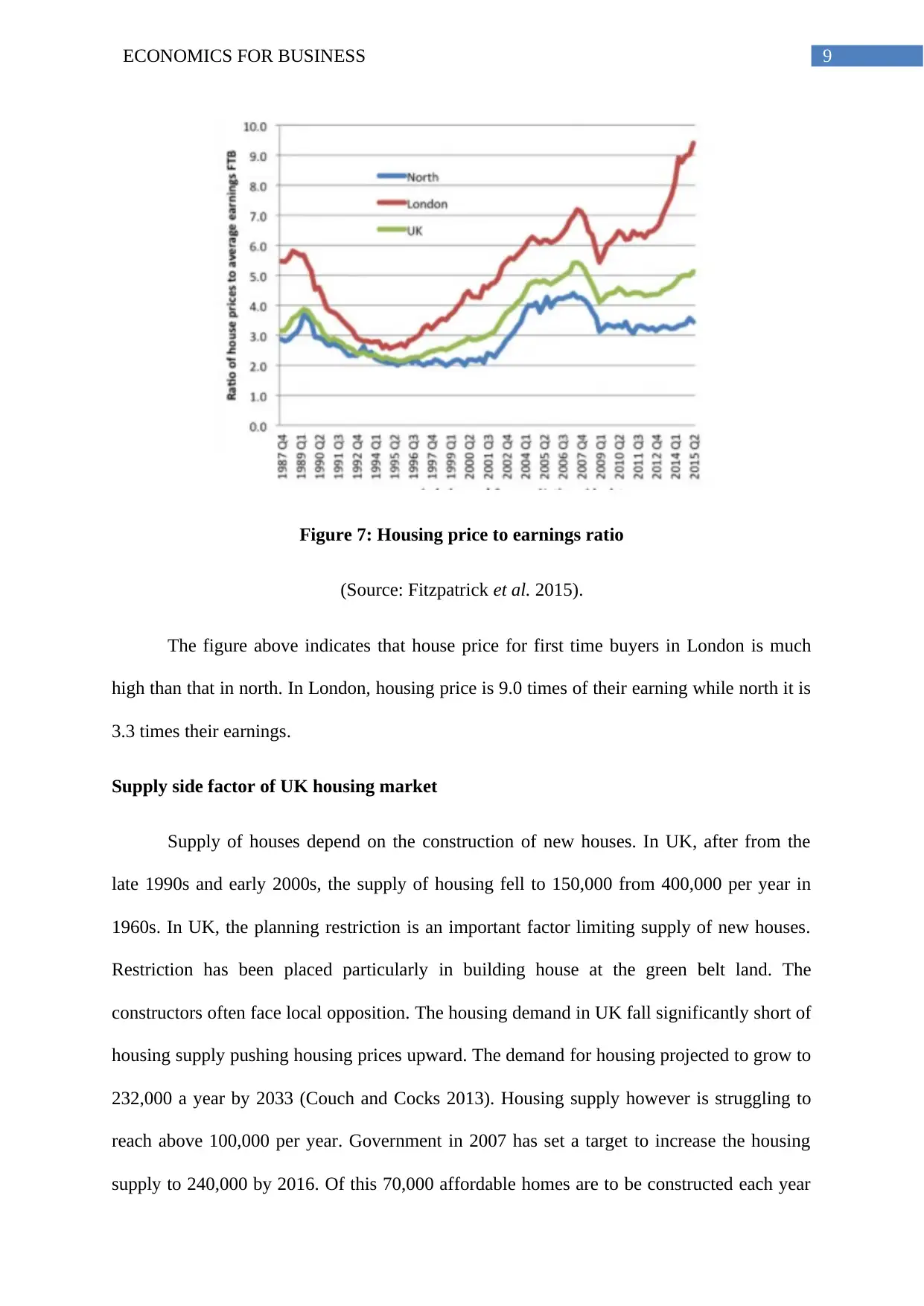
9ECONOMICS FOR BUSINESS
Figure 7: Housing price to earnings ratio
(Source: Fitzpatrick et al. 2015).
The figure above indicates that house price for first time buyers in London is much
high than that in north. In London, housing price is 9.0 times of their earning while north it is
3.3 times their earnings.
Supply side factor of UK housing market
Supply of houses depend on the construction of new houses. In UK, after from the
late 1990s and early 2000s, the supply of housing fell to 150,000 from 400,000 per year in
1960s. In UK, the planning restriction is an important factor limiting supply of new houses.
Restriction has been placed particularly in building house at the green belt land. The
constructors often face local opposition. The housing demand in UK fall significantly short of
housing supply pushing housing prices upward. The demand for housing projected to grow to
232,000 a year by 2033 (Couch and Cocks 2013). Housing supply however is struggling to
reach above 100,000 per year. Government in 2007 has set a target to increase the housing
supply to 240,000 by 2016. Of this 70,000 affordable homes are to be constructed each year
Figure 7: Housing price to earnings ratio
(Source: Fitzpatrick et al. 2015).
The figure above indicates that house price for first time buyers in London is much
high than that in north. In London, housing price is 9.0 times of their earning while north it is
3.3 times their earnings.
Supply side factor of UK housing market
Supply of houses depend on the construction of new houses. In UK, after from the
late 1990s and early 2000s, the supply of housing fell to 150,000 from 400,000 per year in
1960s. In UK, the planning restriction is an important factor limiting supply of new houses.
Restriction has been placed particularly in building house at the green belt land. The
constructors often face local opposition. The housing demand in UK fall significantly short of
housing supply pushing housing prices upward. The demand for housing projected to grow to
232,000 a year by 2033 (Couch and Cocks 2013). Housing supply however is struggling to
reach above 100,000 per year. Government in 2007 has set a target to increase the housing
supply to 240,000 by 2016. Of this 70,000 affordable homes are to be constructed each year
Secure Best Marks with AI Grader
Need help grading? Try our AI Grader for instant feedback on your assignments.
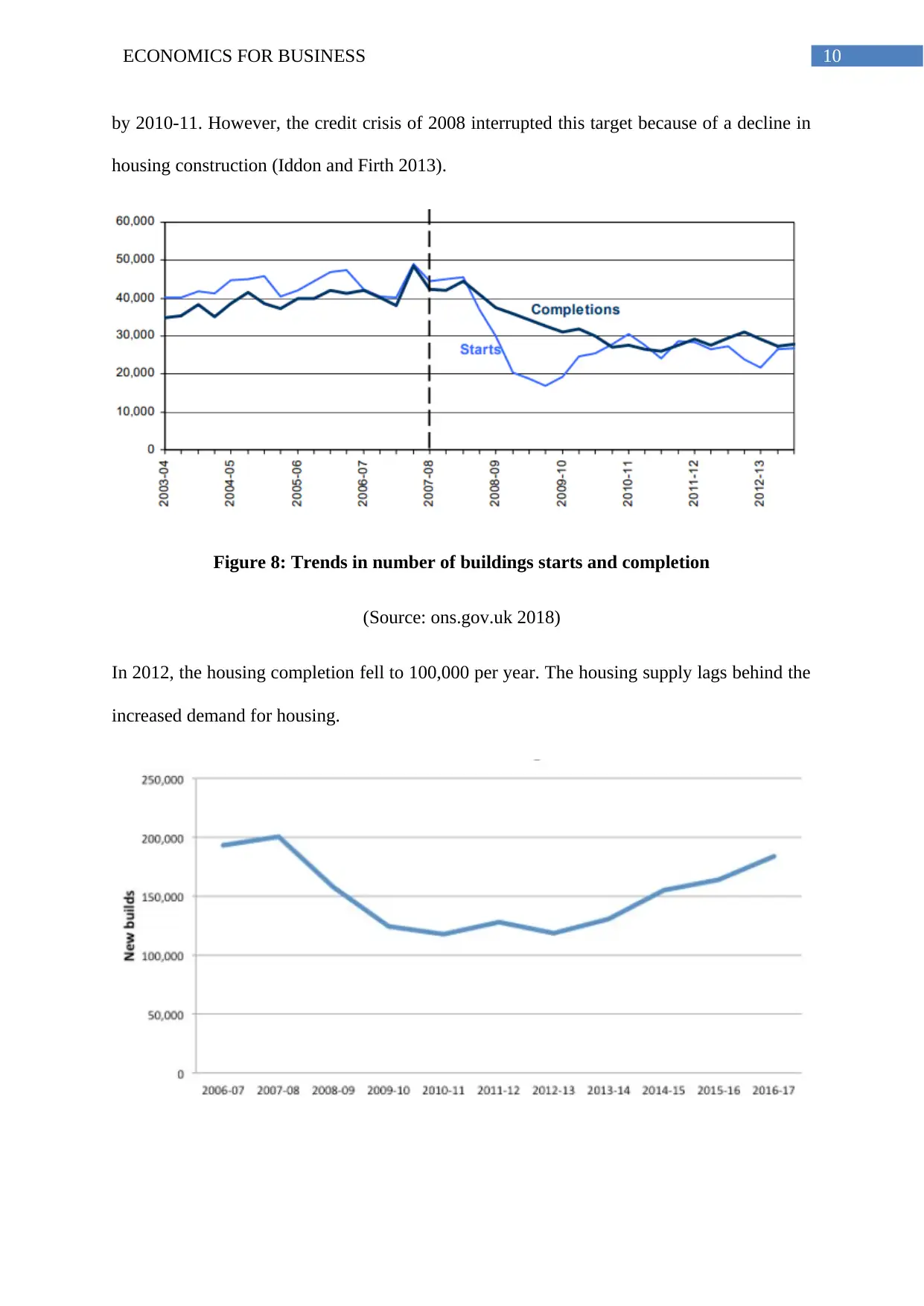
10ECONOMICS FOR BUSINESS
by 2010-11. However, the credit crisis of 2008 interrupted this target because of a decline in
housing construction (Iddon and Firth 2013).
Figure 8: Trends in number of buildings starts and completion
(Source: ons.gov.uk 2018)
In 2012, the housing completion fell to 100,000 per year. The housing supply lags behind the
increased demand for housing.
by 2010-11. However, the credit crisis of 2008 interrupted this target because of a decline in
housing construction (Iddon and Firth 2013).
Figure 8: Trends in number of buildings starts and completion
(Source: ons.gov.uk 2018)
In 2012, the housing completion fell to 100,000 per year. The housing supply lags behind the
increased demand for housing.
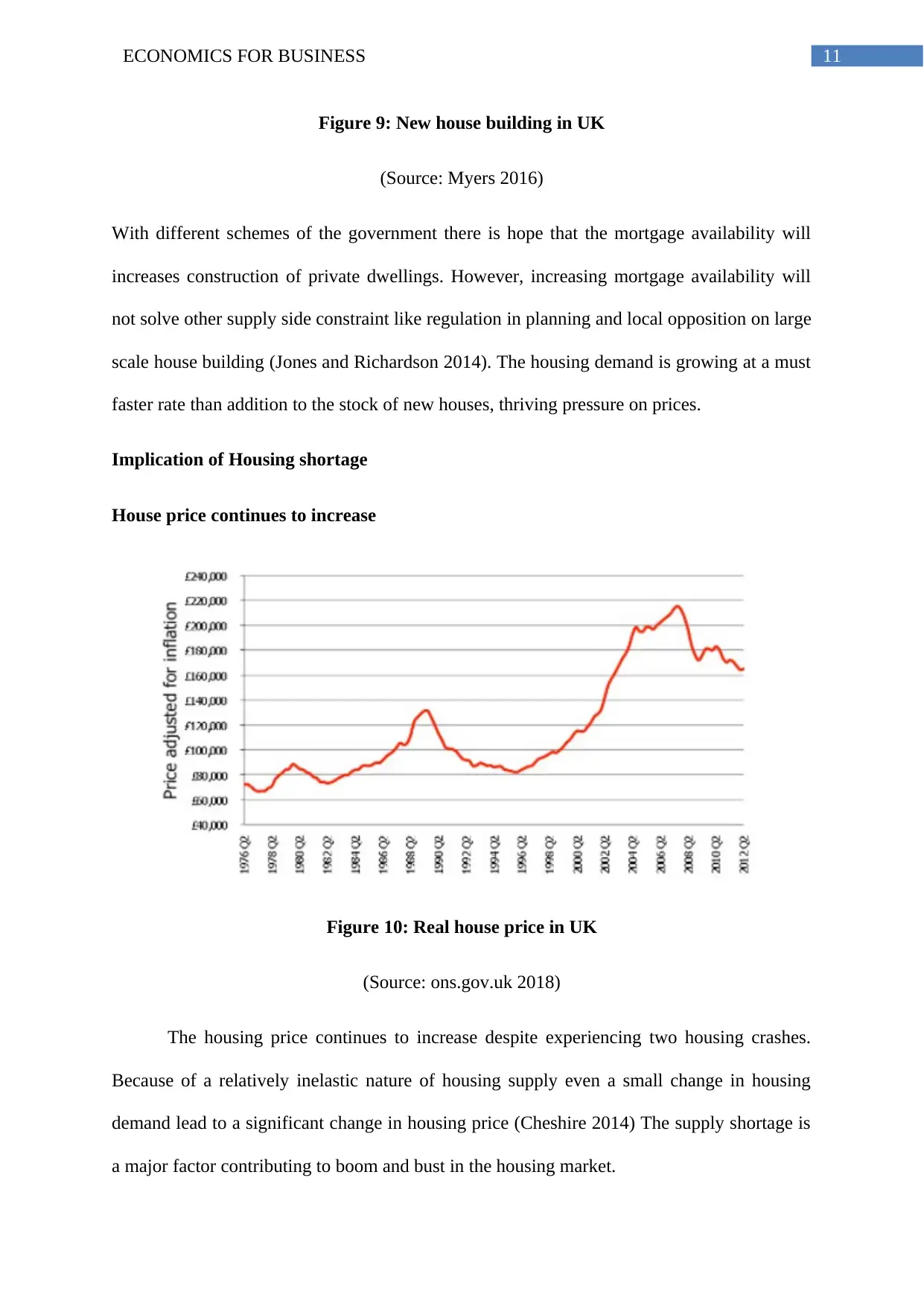
11ECONOMICS FOR BUSINESS
Figure 9: New house building in UK
(Source: Myers 2016)
With different schemes of the government there is hope that the mortgage availability will
increases construction of private dwellings. However, increasing mortgage availability will
not solve other supply side constraint like regulation in planning and local opposition on large
scale house building (Jones and Richardson 2014). The housing demand is growing at a must
faster rate than addition to the stock of new houses, thriving pressure on prices.
Implication of Housing shortage
House price continues to increase
Figure 10: Real house price in UK
(Source: ons.gov.uk 2018)
The housing price continues to increase despite experiencing two housing crashes.
Because of a relatively inelastic nature of housing supply even a small change in housing
demand lead to a significant change in housing price (Cheshire 2014) The supply shortage is
a major factor contributing to boom and bust in the housing market.
Figure 9: New house building in UK
(Source: Myers 2016)
With different schemes of the government there is hope that the mortgage availability will
increases construction of private dwellings. However, increasing mortgage availability will
not solve other supply side constraint like regulation in planning and local opposition on large
scale house building (Jones and Richardson 2014). The housing demand is growing at a must
faster rate than addition to the stock of new houses, thriving pressure on prices.
Implication of Housing shortage
House price continues to increase
Figure 10: Real house price in UK
(Source: ons.gov.uk 2018)
The housing price continues to increase despite experiencing two housing crashes.
Because of a relatively inelastic nature of housing supply even a small change in housing
demand lead to a significant change in housing price (Cheshire 2014) The supply shortage is
a major factor contributing to boom and bust in the housing market.
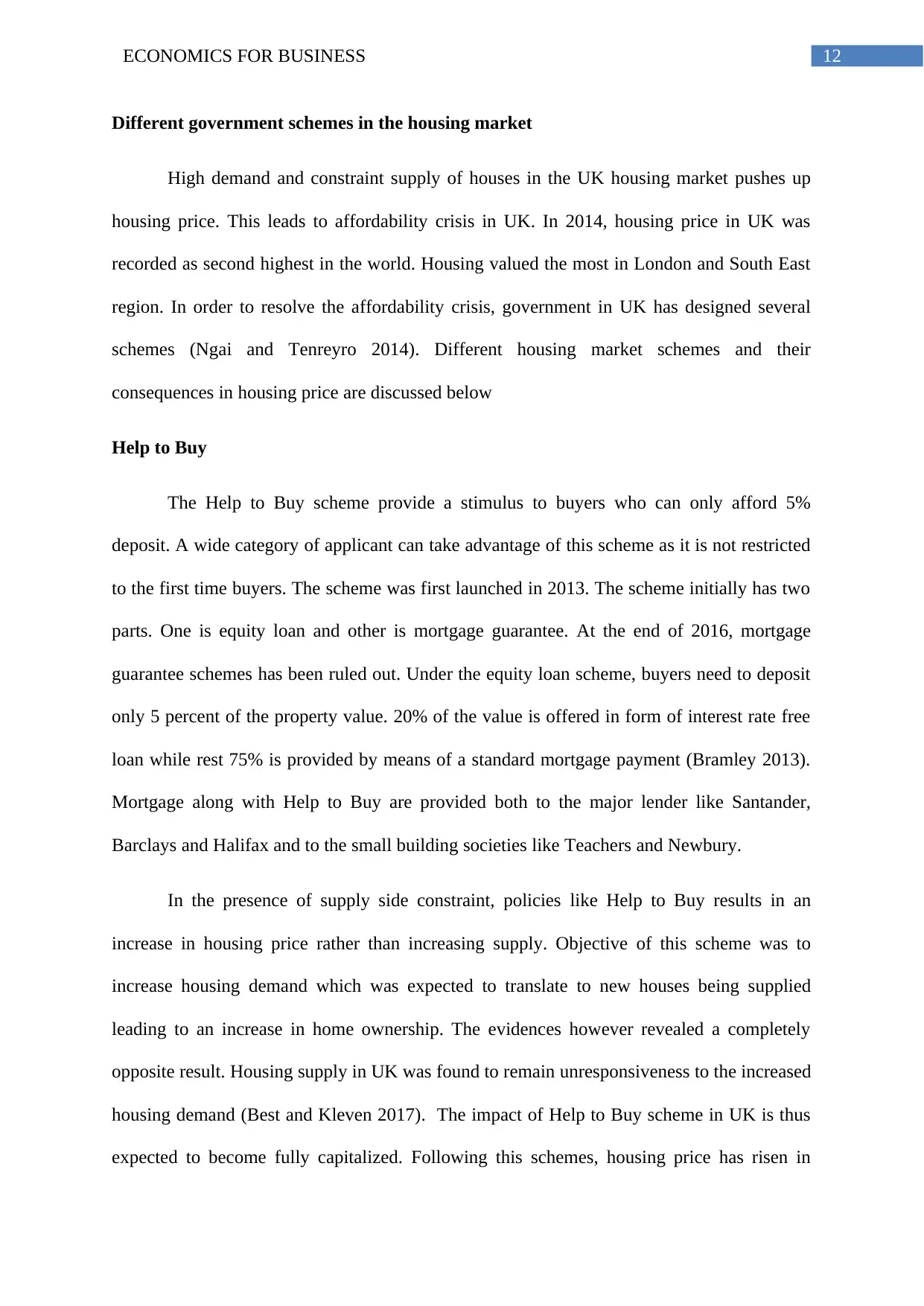
12ECONOMICS FOR BUSINESS
Different government schemes in the housing market
High demand and constraint supply of houses in the UK housing market pushes up
housing price. This leads to affordability crisis in UK. In 2014, housing price in UK was
recorded as second highest in the world. Housing valued the most in London and South East
region. In order to resolve the affordability crisis, government in UK has designed several
schemes (Ngai and Tenreyro 2014). Different housing market schemes and their
consequences in housing price are discussed below
Help to Buy
The Help to Buy scheme provide a stimulus to buyers who can only afford 5%
deposit. A wide category of applicant can take advantage of this scheme as it is not restricted
to the first time buyers. The scheme was first launched in 2013. The scheme initially has two
parts. One is equity loan and other is mortgage guarantee. At the end of 2016, mortgage
guarantee schemes has been ruled out. Under the equity loan scheme, buyers need to deposit
only 5 percent of the property value. 20% of the value is offered in form of interest rate free
loan while rest 75% is provided by means of a standard mortgage payment (Bramley 2013).
Mortgage along with Help to Buy are provided both to the major lender like Santander,
Barclays and Halifax and to the small building societies like Teachers and Newbury.
In the presence of supply side constraint, policies like Help to Buy results in an
increase in housing price rather than increasing supply. Objective of this scheme was to
increase housing demand which was expected to translate to new houses being supplied
leading to an increase in home ownership. The evidences however revealed a completely
opposite result. Housing supply in UK was found to remain unresponsiveness to the increased
housing demand (Best and Kleven 2017). The impact of Help to Buy scheme in UK is thus
expected to become fully capitalized. Following this schemes, housing price has risen in
Different government schemes in the housing market
High demand and constraint supply of houses in the UK housing market pushes up
housing price. This leads to affordability crisis in UK. In 2014, housing price in UK was
recorded as second highest in the world. Housing valued the most in London and South East
region. In order to resolve the affordability crisis, government in UK has designed several
schemes (Ngai and Tenreyro 2014). Different housing market schemes and their
consequences in housing price are discussed below
Help to Buy
The Help to Buy scheme provide a stimulus to buyers who can only afford 5%
deposit. A wide category of applicant can take advantage of this scheme as it is not restricted
to the first time buyers. The scheme was first launched in 2013. The scheme initially has two
parts. One is equity loan and other is mortgage guarantee. At the end of 2016, mortgage
guarantee schemes has been ruled out. Under the equity loan scheme, buyers need to deposit
only 5 percent of the property value. 20% of the value is offered in form of interest rate free
loan while rest 75% is provided by means of a standard mortgage payment (Bramley 2013).
Mortgage along with Help to Buy are provided both to the major lender like Santander,
Barclays and Halifax and to the small building societies like Teachers and Newbury.
In the presence of supply side constraint, policies like Help to Buy results in an
increase in housing price rather than increasing supply. Objective of this scheme was to
increase housing demand which was expected to translate to new houses being supplied
leading to an increase in home ownership. The evidences however revealed a completely
opposite result. Housing supply in UK was found to remain unresponsiveness to the increased
housing demand (Best and Kleven 2017). The impact of Help to Buy scheme in UK is thus
expected to become fully capitalized. Following this schemes, housing price has risen in
Paraphrase This Document
Need a fresh take? Get an instant paraphrase of this document with our AI Paraphraser
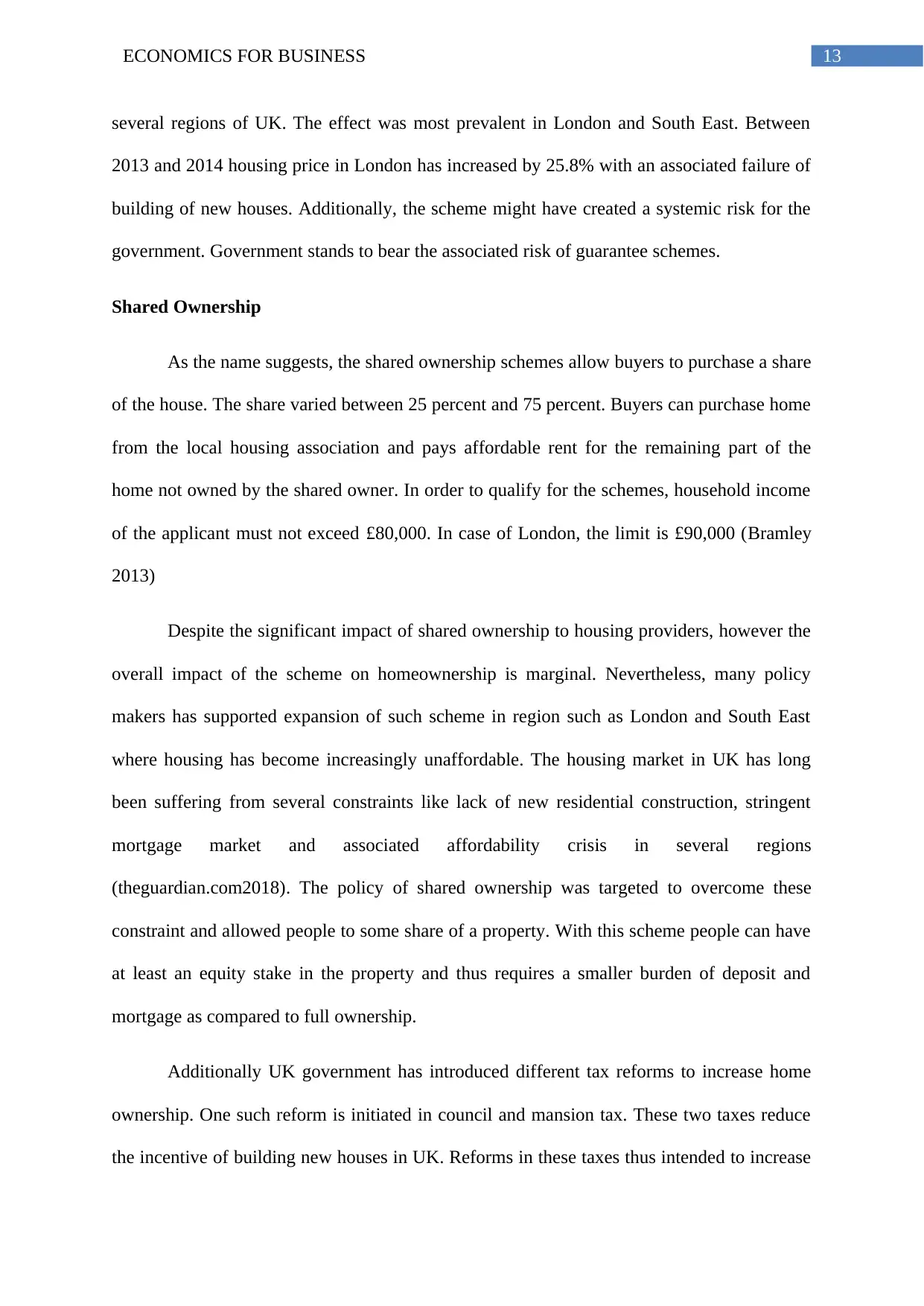
13ECONOMICS FOR BUSINESS
several regions of UK. The effect was most prevalent in London and South East. Between
2013 and 2014 housing price in London has increased by 25.8% with an associated failure of
building of new houses. Additionally, the scheme might have created a systemic risk for the
government. Government stands to bear the associated risk of guarantee schemes.
Shared Ownership
As the name suggests, the shared ownership schemes allow buyers to purchase a share
of the house. The share varied between 25 percent and 75 percent. Buyers can purchase home
from the local housing association and pays affordable rent for the remaining part of the
home not owned by the shared owner. In order to qualify for the schemes, household income
of the applicant must not exceed £80,000. In case of London, the limit is £90,000 (Bramley
2013)
Despite the significant impact of shared ownership to housing providers, however the
overall impact of the scheme on homeownership is marginal. Nevertheless, many policy
makers has supported expansion of such scheme in region such as London and South East
where housing has become increasingly unaffordable. The housing market in UK has long
been suffering from several constraints like lack of new residential construction, stringent
mortgage market and associated affordability crisis in several regions
(theguardian.com2018). The policy of shared ownership was targeted to overcome these
constraint and allowed people to some share of a property. With this scheme people can have
at least an equity stake in the property and thus requires a smaller burden of deposit and
mortgage as compared to full ownership.
Additionally UK government has introduced different tax reforms to increase home
ownership. One such reform is initiated in council and mansion tax. These two taxes reduce
the incentive of building new houses in UK. Reforms in these taxes thus intended to increase
several regions of UK. The effect was most prevalent in London and South East. Between
2013 and 2014 housing price in London has increased by 25.8% with an associated failure of
building of new houses. Additionally, the scheme might have created a systemic risk for the
government. Government stands to bear the associated risk of guarantee schemes.
Shared Ownership
As the name suggests, the shared ownership schemes allow buyers to purchase a share
of the house. The share varied between 25 percent and 75 percent. Buyers can purchase home
from the local housing association and pays affordable rent for the remaining part of the
home not owned by the shared owner. In order to qualify for the schemes, household income
of the applicant must not exceed £80,000. In case of London, the limit is £90,000 (Bramley
2013)
Despite the significant impact of shared ownership to housing providers, however the
overall impact of the scheme on homeownership is marginal. Nevertheless, many policy
makers has supported expansion of such scheme in region such as London and South East
where housing has become increasingly unaffordable. The housing market in UK has long
been suffering from several constraints like lack of new residential construction, stringent
mortgage market and associated affordability crisis in several regions
(theguardian.com2018). The policy of shared ownership was targeted to overcome these
constraint and allowed people to some share of a property. With this scheme people can have
at least an equity stake in the property and thus requires a smaller burden of deposit and
mortgage as compared to full ownership.
Additionally UK government has introduced different tax reforms to increase home
ownership. One such reform is initiated in council and mansion tax. These two taxes reduce
the incentive of building new houses in UK. Reforms in these taxes thus intended to increase
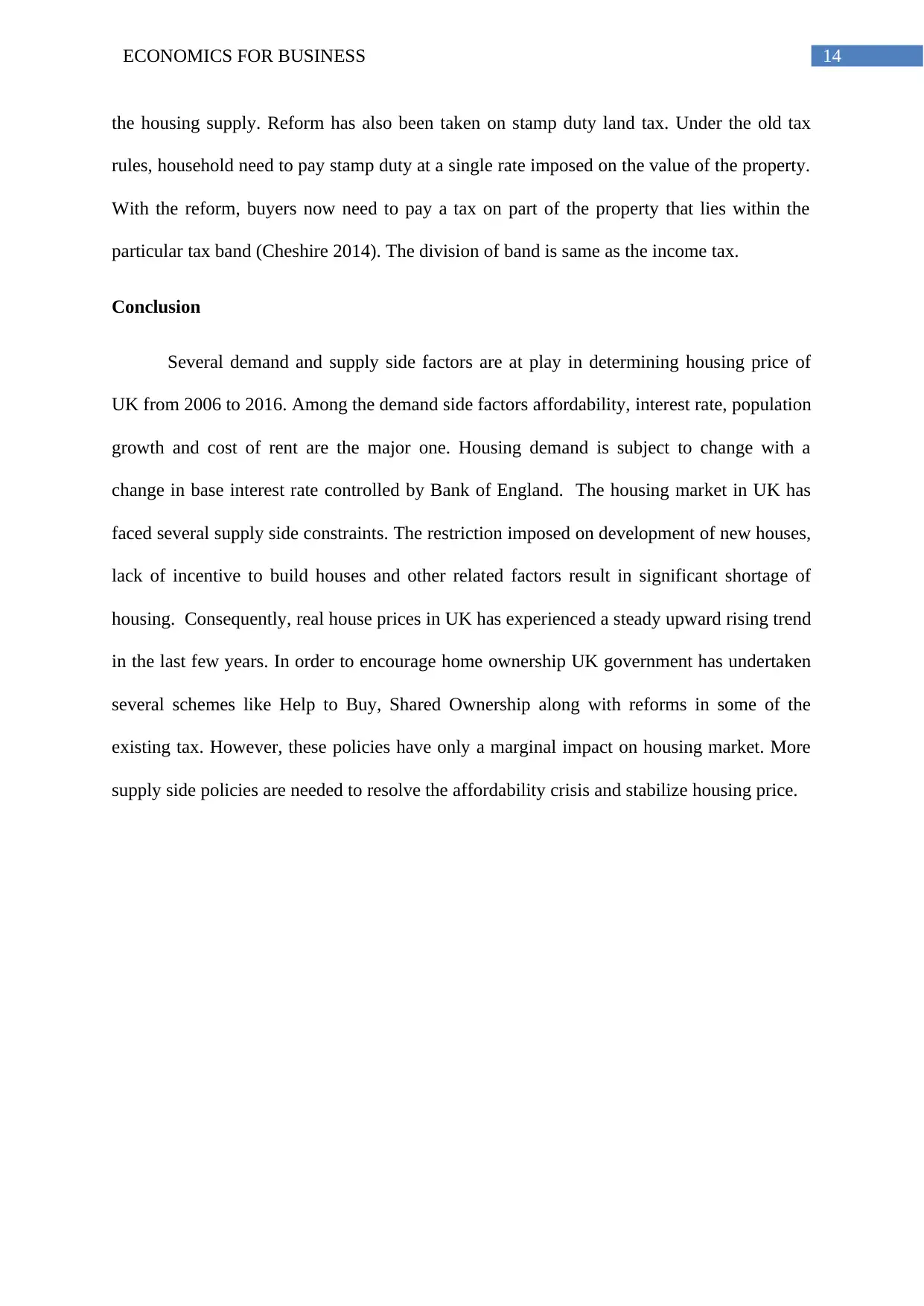
14ECONOMICS FOR BUSINESS
the housing supply. Reform has also been taken on stamp duty land tax. Under the old tax
rules, household need to pay stamp duty at a single rate imposed on the value of the property.
With the reform, buyers now need to pay a tax on part of the property that lies within the
particular tax band (Cheshire 2014). The division of band is same as the income tax.
Conclusion
Several demand and supply side factors are at play in determining housing price of
UK from 2006 to 2016. Among the demand side factors affordability, interest rate, population
growth and cost of rent are the major one. Housing demand is subject to change with a
change in base interest rate controlled by Bank of England. The housing market in UK has
faced several supply side constraints. The restriction imposed on development of new houses,
lack of incentive to build houses and other related factors result in significant shortage of
housing. Consequently, real house prices in UK has experienced a steady upward rising trend
in the last few years. In order to encourage home ownership UK government has undertaken
several schemes like Help to Buy, Shared Ownership along with reforms in some of the
existing tax. However, these policies have only a marginal impact on housing market. More
supply side policies are needed to resolve the affordability crisis and stabilize housing price.
the housing supply. Reform has also been taken on stamp duty land tax. Under the old tax
rules, household need to pay stamp duty at a single rate imposed on the value of the property.
With the reform, buyers now need to pay a tax on part of the property that lies within the
particular tax band (Cheshire 2014). The division of band is same as the income tax.
Conclusion
Several demand and supply side factors are at play in determining housing price of
UK from 2006 to 2016. Among the demand side factors affordability, interest rate, population
growth and cost of rent are the major one. Housing demand is subject to change with a
change in base interest rate controlled by Bank of England. The housing market in UK has
faced several supply side constraints. The restriction imposed on development of new houses,
lack of incentive to build houses and other related factors result in significant shortage of
housing. Consequently, real house prices in UK has experienced a steady upward rising trend
in the last few years. In order to encourage home ownership UK government has undertaken
several schemes like Help to Buy, Shared Ownership along with reforms in some of the
existing tax. However, these policies have only a marginal impact on housing market. More
supply side policies are needed to resolve the affordability crisis and stabilize housing price.
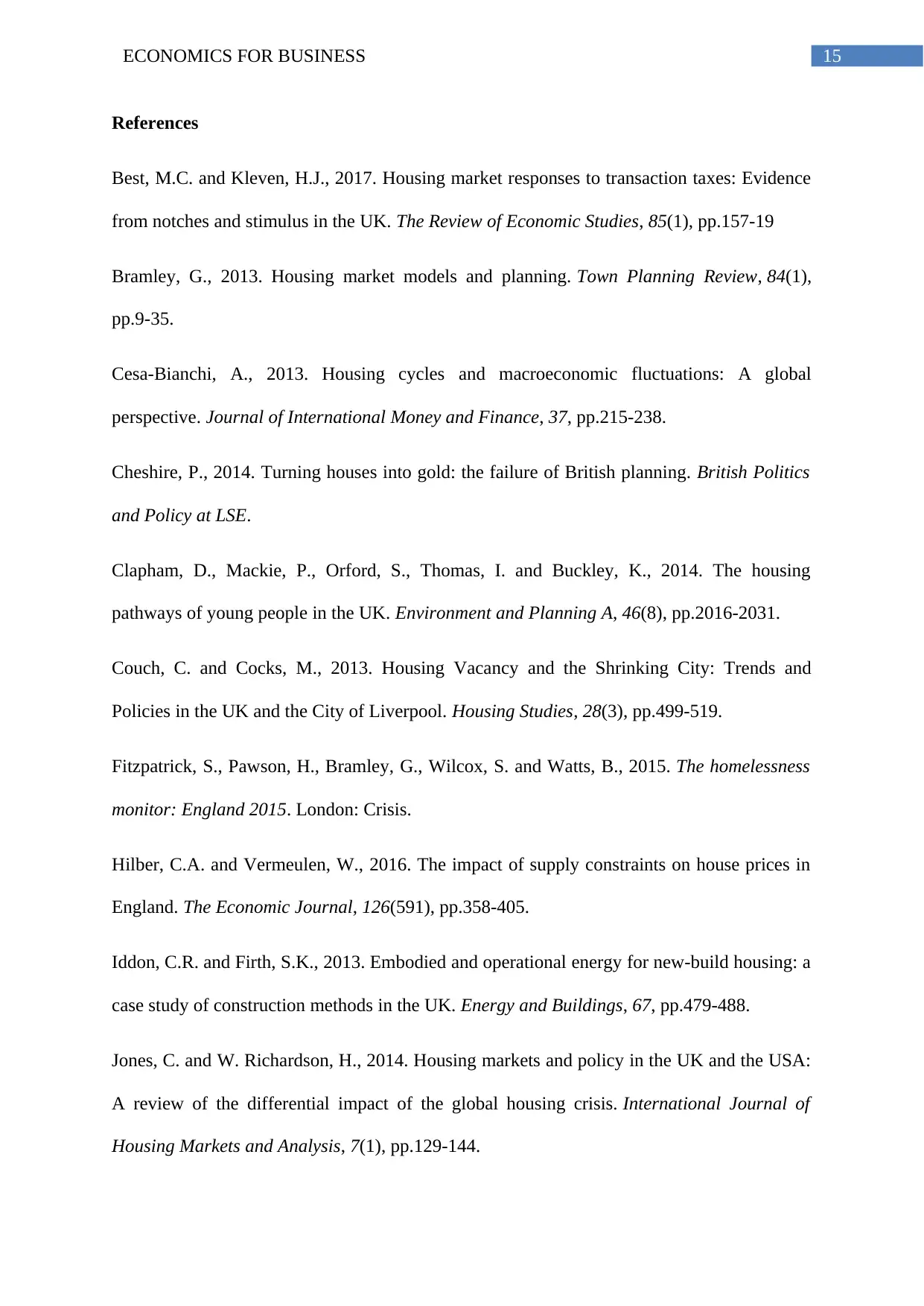
15ECONOMICS FOR BUSINESS
References
Best, M.C. and Kleven, H.J., 2017. Housing market responses to transaction taxes: Evidence
from notches and stimulus in the UK. The Review of Economic Studies, 85(1), pp.157-19
Bramley, G., 2013. Housing market models and planning. Town Planning Review, 84(1),
pp.9-35.
Cesa-Bianchi, A., 2013. Housing cycles and macroeconomic fluctuations: A global
perspective. Journal of International Money and Finance, 37, pp.215-238.
Cheshire, P., 2014. Turning houses into gold: the failure of British planning. British Politics
and Policy at LSE.
Clapham, D., Mackie, P., Orford, S., Thomas, I. and Buckley, K., 2014. The housing
pathways of young people in the UK. Environment and Planning A, 46(8), pp.2016-2031.
Couch, C. and Cocks, M., 2013. Housing Vacancy and the Shrinking City: Trends and
Policies in the UK and the City of Liverpool. Housing Studies, 28(3), pp.499-519.
Fitzpatrick, S., Pawson, H., Bramley, G., Wilcox, S. and Watts, B., 2015. The homelessness
monitor: England 2015. London: Crisis.
Hilber, C.A. and Vermeulen, W., 2016. The impact of supply constraints on house prices in
England. The Economic Journal, 126(591), pp.358-405.
Iddon, C.R. and Firth, S.K., 2013. Embodied and operational energy for new-build housing: a
case study of construction methods in the UK. Energy and Buildings, 67, pp.479-488.
Jones, C. and W. Richardson, H., 2014. Housing markets and policy in the UK and the USA:
A review of the differential impact of the global housing crisis. International Journal of
Housing Markets and Analysis, 7(1), pp.129-144.
References
Best, M.C. and Kleven, H.J., 2017. Housing market responses to transaction taxes: Evidence
from notches and stimulus in the UK. The Review of Economic Studies, 85(1), pp.157-19
Bramley, G., 2013. Housing market models and planning. Town Planning Review, 84(1),
pp.9-35.
Cesa-Bianchi, A., 2013. Housing cycles and macroeconomic fluctuations: A global
perspective. Journal of International Money and Finance, 37, pp.215-238.
Cheshire, P., 2014. Turning houses into gold: the failure of British planning. British Politics
and Policy at LSE.
Clapham, D., Mackie, P., Orford, S., Thomas, I. and Buckley, K., 2014. The housing
pathways of young people in the UK. Environment and Planning A, 46(8), pp.2016-2031.
Couch, C. and Cocks, M., 2013. Housing Vacancy and the Shrinking City: Trends and
Policies in the UK and the City of Liverpool. Housing Studies, 28(3), pp.499-519.
Fitzpatrick, S., Pawson, H., Bramley, G., Wilcox, S. and Watts, B., 2015. The homelessness
monitor: England 2015. London: Crisis.
Hilber, C.A. and Vermeulen, W., 2016. The impact of supply constraints on house prices in
England. The Economic Journal, 126(591), pp.358-405.
Iddon, C.R. and Firth, S.K., 2013. Embodied and operational energy for new-build housing: a
case study of construction methods in the UK. Energy and Buildings, 67, pp.479-488.
Jones, C. and W. Richardson, H., 2014. Housing markets and policy in the UK and the USA:
A review of the differential impact of the global housing crisis. International Journal of
Housing Markets and Analysis, 7(1), pp.129-144.
Secure Best Marks with AI Grader
Need help grading? Try our AI Grader for instant feedback on your assignments.
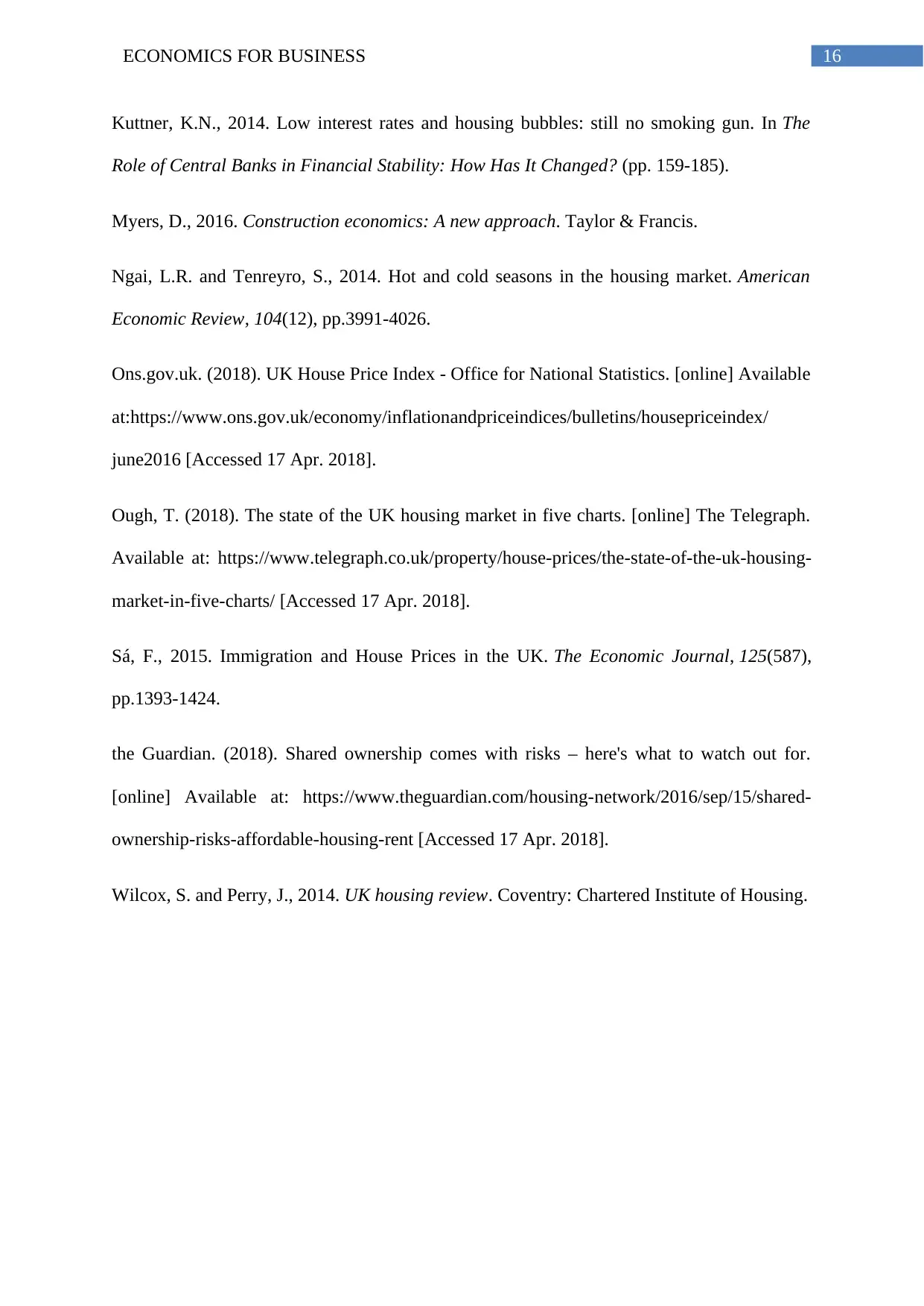
16ECONOMICS FOR BUSINESS
Kuttner, K.N., 2014. Low interest rates and housing bubbles: still no smoking gun. In The
Role of Central Banks in Financial Stability: How Has It Changed? (pp. 159-185).
Myers, D., 2016. Construction economics: A new approach. Taylor & Francis.
Ngai, L.R. and Tenreyro, S., 2014. Hot and cold seasons in the housing market. American
Economic Review, 104(12), pp.3991-4026.
Ons.gov.uk. (2018). UK House Price Index - Office for National Statistics. [online] Available
at:https://www.ons.gov.uk/economy/inflationandpriceindices/bulletins/housepriceindex/
june2016 [Accessed 17 Apr. 2018].
Ough, T. (2018). The state of the UK housing market in five charts. [online] The Telegraph.
Available at: https://www.telegraph.co.uk/property/house-prices/the-state-of-the-uk-housing-
market-in-five-charts/ [Accessed 17 Apr. 2018].
Sá, F., 2015. Immigration and House Prices in the UK. The Economic Journal, 125(587),
pp.1393-1424.
the Guardian. (2018). Shared ownership comes with risks – here's what to watch out for.
[online] Available at: https://www.theguardian.com/housing-network/2016/sep/15/shared-
ownership-risks-affordable-housing-rent [Accessed 17 Apr. 2018].
Wilcox, S. and Perry, J., 2014. UK housing review. Coventry: Chartered Institute of Housing.
Kuttner, K.N., 2014. Low interest rates and housing bubbles: still no smoking gun. In The
Role of Central Banks in Financial Stability: How Has It Changed? (pp. 159-185).
Myers, D., 2016. Construction economics: A new approach. Taylor & Francis.
Ngai, L.R. and Tenreyro, S., 2014. Hot and cold seasons in the housing market. American
Economic Review, 104(12), pp.3991-4026.
Ons.gov.uk. (2018). UK House Price Index - Office for National Statistics. [online] Available
at:https://www.ons.gov.uk/economy/inflationandpriceindices/bulletins/housepriceindex/
june2016 [Accessed 17 Apr. 2018].
Ough, T. (2018). The state of the UK housing market in five charts. [online] The Telegraph.
Available at: https://www.telegraph.co.uk/property/house-prices/the-state-of-the-uk-housing-
market-in-five-charts/ [Accessed 17 Apr. 2018].
Sá, F., 2015. Immigration and House Prices in the UK. The Economic Journal, 125(587),
pp.1393-1424.
the Guardian. (2018). Shared ownership comes with risks – here's what to watch out for.
[online] Available at: https://www.theguardian.com/housing-network/2016/sep/15/shared-
ownership-risks-affordable-housing-rent [Accessed 17 Apr. 2018].
Wilcox, S. and Perry, J., 2014. UK housing review. Coventry: Chartered Institute of Housing.
1 out of 17
Related Documents
Your All-in-One AI-Powered Toolkit for Academic Success.
+13062052269
info@desklib.com
Available 24*7 on WhatsApp / Email
![[object Object]](/_next/static/media/star-bottom.7253800d.svg)
Unlock your academic potential
© 2024 | Zucol Services PVT LTD | All rights reserved.





